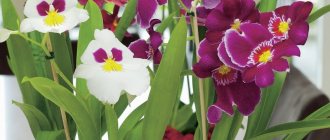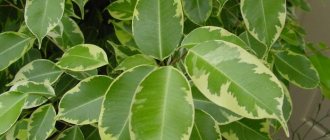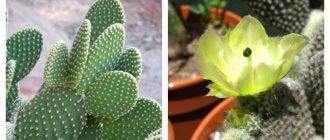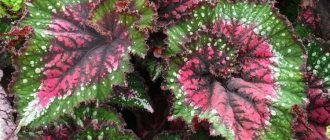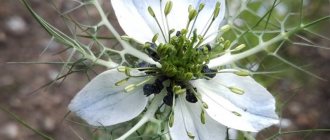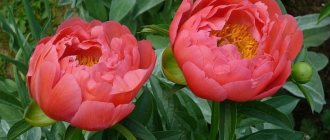How to grow a capricious Venus flytrap on a windowsill: what insects to feed it, how to water and care for it
Many people have heard about carnivorous plants. Some insectivorous plants can also be grown on your windowsill. The Venus flytrap feels great at home and even eats flies, spiders and other living creatures. True, she needs careful and special care. In this article, for those who decide to buy a Venus flytrap, we will try to tell everything about this plant.
Nepenthes
This is a trap flower with water lily shaped leaves. There are more than 130 varieties that grow in Sumatra, India, China, and Australia. There is also another name for the flower - monkey cup. That's what scientists called it when they conducted research and witnessed how monkeys drank from them the water that accumulated after the rain.
This flytrap looks like this: a 15 meter tall vine with shallow roots. On the stem part of the plant there are leaves with peculiar tendrils. They protrude from the tips of the leaves.
Interesting!
At the end of the antennae there is a small vessel that, when expanded, forms a deep cup; this is a trap for the insect. This trap contains a watery or sticky liquid that attracts flies.
Sarracenia (left) and Nepenthes (right)
How to grow a Venus flytrap at home
Interestingly, this predatory flower grows well both in the wild and in ornamental gardening. Moreover, you can grow a Venus flytrap at home, however, careful care is required, especially monitoring the level of humidity in the room in the winter, when heaters dry the air.
It cannot be said that the Venus flytrap is a whimsical plant for growing at home. Since its natural habitat is the coast of the Atlantic Ocean, the plant is accustomed to seasonal temperature changes. Under natural conditions, even with the first frosts and snowfall, the Venus flytrap does not die, but the flower cannot withstand severe and prolonged frosts. In winter, at home, the lower rosette of leaves remains from the plant, that is, the ground part on which the plant feeds dies.
Until spring, the V. flycatcher is in a dormant state, but with the first warmth and sunlight, the plant begins to lead its predatory lifestyle.
The underground short stem - the bulb begins to actively fill with juice, a rosette of seven leaves appears, each of which can reach up to 10 centimeters. The leaves sprout alternately, one above the other, according to the “storey” principle. Along with the first leaves, stems appear on which quite beautiful white flowers bloom. And only after the plant fades, the leaves transform into a trap. This is the basic information from the field of botany that exotic flower growers need to know.
It is fair to say that now this exotic plant is increasingly being grown at home. The flower can grow both in an apartment on the windowsill and in the garden.
Caring for a Venus flytrap is quite simple, but there are a few things to keep in mind.
In order for a flower to feel comfortable at home, you need to follow one of the main rules of care, namely, imitation of natural conditions:
- sufficient humidity - there should always be water in the pan (except for the rest period);
- sandy-peaty soil - soil from the garden is not suitable for growing this plant due to its acidity;
- good level of light, but not on the south side, or light shading.
Although the plant is light-loving, it does not tolerate stagnant hot air, so regular ventilation is necessary. In general, if you want your flycatcher to feel comfortable in your home, care is simple - keep it on the sunny side, open the windows more often and use air conditioners whenever possible to humidify the air. In winter, there is no need to place the pot next to the heaters.
For proper care, you should keep the Venus flytrap in a pot on a tray with a supply of clean or rain water - after all, the plant loves wetlands in nature.
Stapelia
This is a cactus that eats flies. It has no stem, but its fuzzy flowers with spots resemble a sea creature. Another name for the plant: star cactus, large toad flower. May also be called starfish. The diameter of the flowers is about 40 cm. The smell of decaying flesh is very attractive to flies, beetles and larvae. They crawl into the central part of the plant, where they die.
On a note!
Place of growth of slipway South Africa. But the flower is often grown in Russia to decorate a stone garden or home landscape.
Lysiheaton
It mainly grows near swampy areas, river banks and ponds in North America. The Indians used it for cooking and treating various diseases.
This is a stinky plant that smells like a scared skunk. That's why it was nicknamed skunk cabbage. This smell attracts insects. This plant can also raise its temperature to survive the winter.
Plants that eat flies
Devil's fingers
This mushroom at first looks like a chicken egg with a heterogeneous lumpy surface, gray in color and brownish and pinkish spots at the base. But when its blades open, it looks like a star-shaped flower with many tentacles. Inside the plant is lumpy, spongy with dark mucus. Insects are attracted to the cadaverous smell that the plant emits. A photo of a flower that eats flies is shown below.
Plants that eat flies
Darlingtonia
Place of growth: Oregon, California. It grows in springs and swamps, a rare plant. The bulbous leaves form a cavity with an opening for insects to enter. It is located under an airy structure and 2 sharp hanging leaves, they look like fangs.
A crab claw trap is used. When the fly gets inside the plant, it dies. The insect is confused by the light that shines through the plant. They follow thick thin villi far into the depths until they enter the digestive organ. But they will never be able to go back.
Variety of traps
All carnivorous plants, according to the method of catching, are divided into those who catch actively and passively. Active catchers have special baits that move and thereby attract the attention of insects. This group includes sundew and flycatcher.
Passive catchers form traps in the form of sticky and mucous secretions on the leaves, jugs, and bubbles.
It is difficult to understand whose strategy is better, but since these adaptations exist, it means it is beneficial for this species. The flycatcher and sundew spend energy moving, but they also catch more. Passive plants wait patiently, like a spider in its web, for someone to crawl towards them. But they don’t have to waste any extra energy—catch an insect and wait quietly again.
Bladderwort catching a fish fry
All the diversity of carnivorous plant species does not use many types of traps. This is due to the fact that it is mainly the leaves that evolve into the trap. So nature had no reason to create too many traps. There are five main types of traps:
- leaves rolled into a jug;
- traps made of two leaves;
- Velcro on leaf blades;
- traps with the effect of being sucked into liquid;
- something like a crab claw.
A distinctive feature of these devices is the complete absence of any connection between the type of trap and the taxonomic affiliation of the species.
Zhiryanka
To lure and digest prey, the plant uses sticky, glandular foliage, similar in principle to duct tape. Nutrients after digestion by the insect feed the soil with mineral compounds. Place of growth Asia, Europe, North and South America. There are about 80 varieties there.
The leaves of this plant are pink or green. There are 2 types of cells that are located on the upper side of the foliage. One of them is the flowering gland, consisting of secretory cells. They produce a sticky mucus that forms droplets on the surface of the foliage. The second cell is sessile glands. They produce secretions that aid digestion. Most species of Zhiryanka feed on insects all year round. But there are also flowers that feed on flies when summer comes. It blooms again, new carnivorous foliage appears.
Plants that eat flies
Methods of propagation of the Venus flytrap
Dionea can be propagated in three ways:
- dividing the bush (bulb);
- leaf cuttings;
- from seed.
The bush is divided in the spring after hibernation, during the replanting of the flycatcher. The bush is removed, shaken off the soil and divided into bulbs. The separated onion should have roots. It is placed with the roots down in the prepared substrate and sprinkled, leaving only the sprout on top. The top of the former shoot is removed and sprinkled with coal. The soil should be moist; for the first time, you can cover the container with transparent material and place it in a brightly lit place, this will allow the seedling to take root faster. After the first leaves appear, care is carried out as for an adult plant.
Venus flytrap cuttings are taken from a healthy plant. To do this, a leaf is pinched off at the base of the roots, its trap is removed, and the cutting itself is placed in a greenhouse. The presence of white color at the bottom of the stem indicates the correct separation of the cutting. It is recommended to maintain very high humidity and good lighting, and periodically ventilate the planting to avoid rotting. If all conditions are met, the leaf will die, giving life to a small seedling. After two to three months, it can be transplanted and cared for as usual.
Growing a Venus flytrap from seed is the most time-consuming and difficult approach.
The seeds are grown in a special greenhouse, it can be just a box covered with transparent polyethylene or glass. The purchased seeds must be no older than a year, otherwise there is a possibility that they will not germinate. First they indulge in cold stratification. One way is to place them in soil, damp gauze or a napkin, wrap them tightly in film and put them in the refrigerator for a month and a half. Before this, it is necessary to treat the seeds with a solution of a fungicide, for example, topaz in the proportions of two drops per glass of distilled water.
Seeds obtained from a flower box are best sown within 2-3 days. When healthy and ripe, they should have a black, smooth, hard surface, shaped like a droplet. The seed capsule must be completely dry, usually it contains about 30 seeds about 2 mm in size.
The optimal period for sowing will be the end of September or the beginning of October.
Seeds are poured into the moist soil prepared for the flytrap, and it is allowed to sprinkle them a little with the substrate. Next, the pot is covered and placed in a warm (25-27 °C), humid (40-60%), brightly lit place. The main conditions are lighting in the sun or under a fluorescent lamp for at least 16 hours every day, and bottom watering of the soil. Shoots are expected within a period of one to three months. As soon as the leaves appear, the seedlings will need to be ventilated periodically by opening the greenhouse lid
During the first three months, the mature plants are planted in separate containers, being careful with the roots. Further care is carried out by fulfilling the conditions described above for the Venus flytrap. A full-fledged, mature plant grown from seed should be expected no earlier than after 5 years
A full-fledged, mature plant grown from seed should be expected no earlier than after 5 years.
After growing by any of the methods, the plant will grow for about 5 months, and then it will begin to prepare for winter and lose its activity. To stop hibernation, the flycatcher can be transplanted into new soil, after which it will still grow, but wintering must be carried out.
Sundew
They grow in Russia, Siberia and the Far Eastern regions. They can exist even in severe frosts, forming thermal insulation on the buds. In spring, the hunt for flies and other insects begins. The leaves are covered with thin red fibers, they produce droplets in the form of dew. During the first warm months, the Sundew feeds on bugs, then on pollinating insects.
Interesting!
Sundew has a deadly effect on insects, but it is very useful for humans. The plant helps alleviate the condition of epileptic seizures, bronchitis, asthma, and atherosclerosis.
Predatory plants in the house
The choice should be made in favor of Sundew or Flycatcher. After you buy an indoor flower that catches flies, it needs some time to adapt to a new place. From time to time you will have to catch several live insects for him, because they are the ones who activate the digestive process. You cannot feed it with large bugs; they should be half the size of the trap itself. Three flies a day are enough, no more.
Plant propagation
Insectivorous plants are propagated by dividing the bush or by cuttings; the flowers themselves prefer pollination. In nature, insects help them, but at home they have to get used to manually transferring pollen from the stamens to the pistil. Many species bloom at the end of spring.
In nature, these flowers reproduce by pollination, but cuttings are also possible at home.
Winter care
In winter, carnivorous plants stop growing and go dormant. During this time, the flower gains strength for further growth and flowering. During this period, you need to continue to care for the plant, removing dried leaves and watering.
Home conditions
The following carnivorous flowers can be kept indoors:
- tropical butterwort;
- sundew;
- Venus flytrap;
- sarracenia.
It is better to keep a pot with a carnivorous flower in a well-lit place. This could be a windowsill or artificial lighting (in winter, with a lack of sunlight). Such flowers love moist soil, so you need to avoid drought and water them in time with melted, slightly acidic or neutral water. Salts in tap water can kill the plant. Carnivorous flowers need moderate temperatures: +15...+30°C in summer and +10...+14°C in winter.
